Some of the links in this post may be affiliate links.
Table of Contents
Alocasia Amazonica & Polly Care
The notorious Alocasia amazonica. Everyone wants to grow it, but the problem is that a lot of people kill it! This is a challenging houseplant, but don’t despair! This plant is also known as Alocasia x amazonica and is actually a cross between Alocasia longiloba and Alocasia sanderiana.
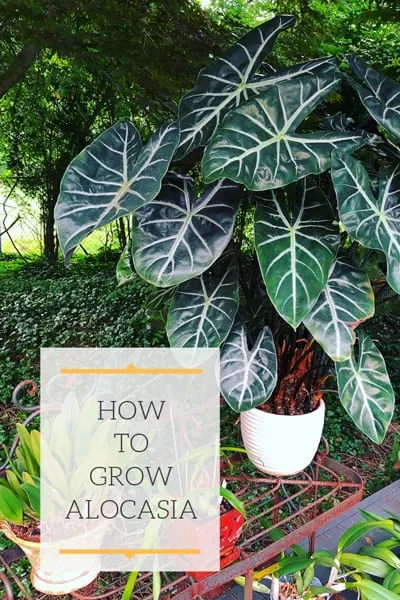
Alocasia x amazonica care is not insurmountable by any means once you understand it. Like many people, I was seduced by the dark green, glossy leaves with sharply contrasting veins, as well as by the striking shape and form of the leaves.
My plant looks beautiful now, but it wasn’t always in tip-top shape. See, I’m human too. I’ve also become notorious on Instagram and have been offering so much advice that I decided to write a blog post. I got tired of explaining what to do repeatedly, so here we are!
Anyway, I’ve learned through the years not only how to keep this plant from dying, but how to make it thrive. I wanted to share my tips with you so keep reading!
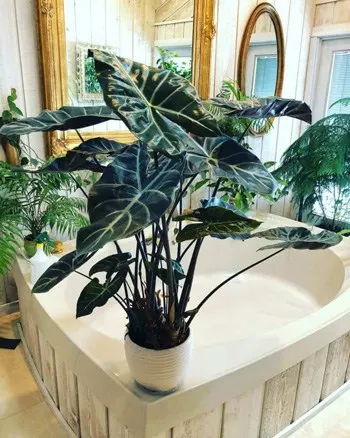
The plant shown in the photo above is actually Alocasia longiloba, after doing some research, but the care is identical to Alocasia amazonica. After all, the longiloba species is one of the parents of the Alocasia amazonica artificial hybrid.
Alocasia amazonica and Alocasia Polly are different varieties, but Polly is a bit smaller. You can treat the care as identical.
Origins of Alocasia amazonica
Even the name of this plant is misleading! When you see Alocasia amazonica, you might think that it is a a species that comes from the Amazon rainforest.
In fact, it is NOT a species and it doesn’t even come from the Amazon.
Like I mentioned previously, it is supposedly a hybrid between Alocasia longiloba crossed with Alocasia sanderiana, both of which are Asian species. The name amazonica comes from the name of the nursery where this hybrid was created in Florida.
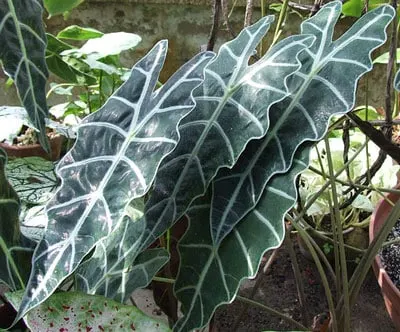
Alocasia Amazonica Light Requirements
These plants need bright indirect light to do their best. A little bit of morning sun or filtered sunlight is great, but keep this plant away from harsh, direct sunlight.
This is definitely a plant that you do need to keep very close to a window. And by very close, I mean right in front of it, but without touching the window.
There are some plants that can survive locations far from a window, but this is not one of them.
If you can not place this plant right in front of a window to receiver proper light, then I would suggest you look for another plant because it’ll just end up in disappointment!
These plants can be finicky enough, so don’t set yourself up for failure!
I find it important to really specify that it needs to be in front of a window, because many people think that they can place a houseplant anywhere, and then they are surprised when it dies.
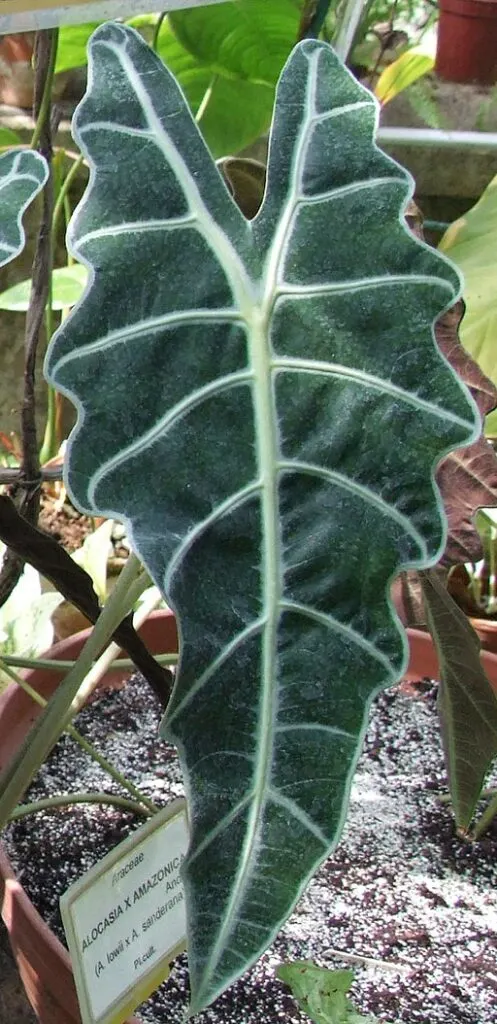
Sure there ARE plants that can SURVIVE and even sometimes do pretty well several feet from a window….or even in rooms that have no windows (but that have plenty of bright overhead lights), but this plant is NOT one of them.
If you DO want to know good plants that you can grow away from a window or in darker conditions, be sure to read my blog post about plants that can grow in the dark! Ok, growing in the dark is a bit of an exaggeration, but you won’t want to miss this post.
Remember, plants use light to photosynthesize and make their own food, so if you’re not giving your plant the light that it needs, you are basically starving your plant. Shame on you!
Situating your plant in an area with proper lighting should be the single most important concern that you need to take care of.
My own Alocasia amazonica (ok, technically I have an Alocasia longiloba, but the care is identical) is growing in my sunroom right in front of a large Eastern exposure sliding door so it gets plenty of light.
There is also a skylight in that room, and a large wall of Northern exposure windows.

Alocasia Amazonica Water Requirements
Next to adequate light, proper watering is the next most important thing in keeping your Alocasia amazonica in good shape. Actually, EVERYTHING I’m mentioning in this blog post is probably equally important so take note. These plants LOVE their water and do not take neglect very kindly.
Years ago, my specimen was growing in a terra cotta pot and this was a big mistake. The soil dried out very quickly, and the plant was kept much too dry for its liking.
I kept losing leaf after leaf and it looked pretty pathetic, but it was still alive! After that, I repotted it into a glazed ceramic container and it was much easier to manage its moisture requirements.
We all make mistakes! This was before I really had read more about this plant and researched its need.
Except in the winter time, you’ll want to keep this plant pretty evenly moist. In the winter, I let the top of the soil dry out a little before I water again.
But don’t let your Alocasia amazonica get TOTALLY dry otherwise it will start to go dormant. This is not a plant that you can neglect the watering. If you’re looking for a carefree houseplant, then go buy something else.
If you want plants that you can neglect, you may be more suited to Sansevieria and there are plenty of varieties to keep your interest!
You’ll have to be very vigilant and careful with the watering with this Alocasia. When winter is over and the days are getting longer, the plant is growing and the lighting is brighter, so you can increase the watering.
Alocasias in general are moisture loving plants so bone dry soil spells disaster for these plants. On the other hand, I would also generally avoid these plants sitting in water for extended periods of time. It’s all about a balance!
Alocasia Amazonica Care Outdoors
The best thing that I do for my Alocasia is place it outside in the summer. It absolutely flourishes outside in the summer! Make sure that you place it in a protected place though. One year, my plant blew over and the pot broke and part of the plant got damaged!
After that happened, I made sure to secure the pot well so that the wind could not blow it over.
When this plant is placed outside, the wonderful air circulation, higher humidity, rainwater, and brighter light really work wonders for this plant. Place it in a sheltered spot in the shade or in filtered/dappled sunlight at the very most.
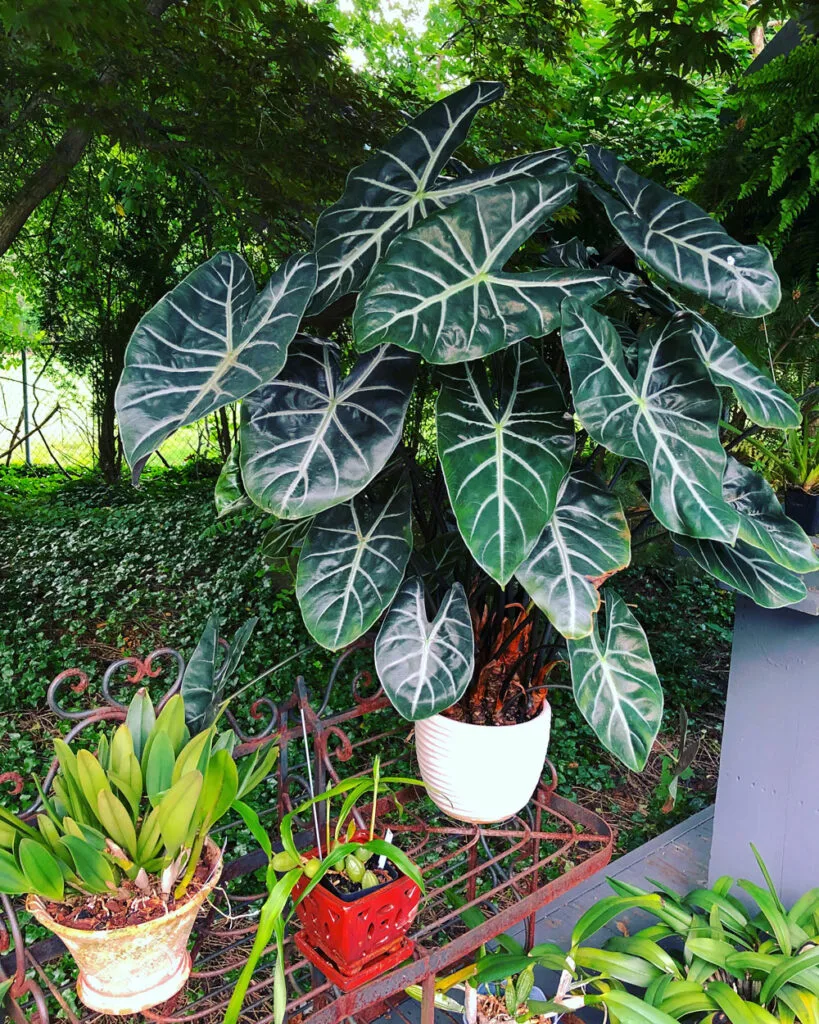
Anytime you place a houseplant outdoors, after it has been indoors for a while, you must harden your plant off. This means that you need to gradually acclimate your plant to outdoor conditions so it doesn’t go into shock.
Be sure to read my blog post on how to transition your houseplants to go outside. I have had one too many people complain to me that they burned their plants because they didn’t properly harden them off.
In the heat of the summer, I’ll even water my Alocasia daily sometimes when it is outside! Remember that you should NOT worry about how often you water. Don’t look at your calendar when you water. Especially when you have plants outside.
Instead, you should just go by how dry the soil is to determine when you should water. Whether the plant is indoors or outdoors.
The rapid growth and warm temperatures will dry out the soil much more quickly than indoors so you’ll need to provide plenty of water for your plant if you move it outdoors.
And don’t worry if daily seems too frequent…it’s NOT during the heat of the summer. Don’t judge when to water a plant by the frequency! “Oh I watered it two days ago…it should be good. I don’t want to overwater it.”
That will prove hideously false if it’s hot outside and the plant is totally dry. Especially when it is hot outside, it will need all the moisture it can get.
Water when it NEEDS it, not when your schedule tells you to. And throw everything out the window if you move a houseplant outside for the summer.
Your weekly indoor watering routine that you may have been doing suddenly may not work anymore, so you’ll have to pay attention to your plants when they are outside because the environmental conditions are very different from your indoor conditions.
When your Alocasia is outside, each consecutive leaf grows bigger and bigger, and it really increases in size beautifully.
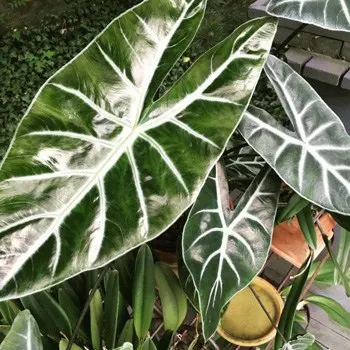
But you’ll only want to keep it outside if it is warm enough, which brings us to…
Alocasia Amazonica Temperature Requirements
We all know that one person that always seems to be cold. Everywhere. Always wearing a sweater even when it seems comfortable to other people.
Well, this plant is like your frigid friend. They’re going to complain at every chance they get.
If you place this plant outside, please make sure that the minimum nighttime temperature stays at LEAST 50-55 degrees Fahrenheit (approximately 10-13 Celcius) if not warmer! A safer bet would be a minimum of 60F.
If the temperature dips below 50F (10C) or so, especially for extended periods, you may as well kiss this plant goodbye. They detest the cold and will protest with yellowing leaves and start to go dormant.
Keep it cold long enough, and you will have to start planning a funeral. This goes for indoors as well.
If it is consistently below the 50-55F range, it’ll start going dormant and you will lose one leaf at a time until there is nothing left.
Many people have reached out to me about their leaves yellowing and falling one by one. In a few cases, it turned out that the rooms where their Alocasias were growing had plunged into the 40s Fahrenheit.
This is MUCH too cold for these plants and they simply will not tolerate it. So make sure you have a mild to warm spot for your plant!
If you can not provide these conditions and you acquire one of these plants anyway, then you may as well start planning that Alocasia funeral…
Also, try to avoid placing this plant in areas that have cold drafts. Conversely, try avoiding placing these plants right next to a heating vent. Demanding isn’t she?
Alocasia Amazonica Fertilizer Requirements
I just use whatever all-purpose fertilizer I have on hand, and use a variety of fertilizers depending on the season. Check out my recommendations below, available on Amazon for convenience:
Right now I’m using Dyna-Gro Grow fertilizer on most of my houseplants. Do not feed your plant in the winter since it will be either growing very slowly or not at all.
When I take my plant outside, I will rotate different fertilizers, including some organic fertilizers. I love using Neptune’s Harvest fish emulsion and seaweed fertilizer in the warm months.
In general, I like to fertilize at every watering when my plant is indoors, but the concentration is more dilute since I’m applying at every watering. The exception is the winter when I don’t fertilize at all.
In the summer, I like to use the fish emulsion fertilizer mentioned above about once a week.
Alocasia Amazonica Humidity Requirements
Humidity is very important for these plants. There are many things that you can do to increase the humidity for your Alocasia.
Firstly though, let me explain a common practice that actually does NOT increase the humidity and can actually be dangerous if you do it incorrectly.
Many people mist their houseplants. This actually does nothing for the humidity. Humidity is a measure of moisture in the air. All you’re doing by misting is wetting the leaves.
You’re not changing the humidity of the air. In fact, it can be dangerous if you mist too frequently, especially if the temperatures are cooler, because you might be encouraging bacterial and fungal infections.
Misting at night is especially dangerous because the cooler temperatures and wet leaves can encourage diseases particularly well at that time. I never mist my Alocasia.
This is not to say that I never mist any of my plants. For example, my cast iron plant used to get spider mites in the winter, but I took care of that problem and found that I was able to prevent that issue from occurring by misting it during the winter.
Some viable ways to increase the humidity for your Alocasia are the following:
My preferred way is to get a humidifier and run it in the room where your plants are. There are many varieties out there, but I use a warm-mist humidifier with a pretty large water reservoir.
My absolutely FAVORITE humidifier is the Levoit humidifier. You can run it on cold mist or warm mist, has a remote control, operates very quietly and is just amazing! I highly recommend this humidifier and I have been very happy with it.It’ll actually operate for several hours and then it automatically shuts off when the water is depleted. Sometimes I forget to turn it on, but when I do run it, I make sure to start running it in the morning or at the latest by early afternoon.
I avoid running humidifiers in the evening and I use them mainly in the winter months when forced air heat really dries out the air! I live in a cold-winter climate. Some of my readers live in sub-tropical and tropical areas so you can probably ignore this section of the blog post altogether!
Grouping plants together is another way to increase the local humidity around your plants. Plants naturally release water through their leaves in a process called transpiration.
If you group a lot of plants closely together in one area, you’ll create a mini microclimate with higher humidity.
The last way I will mention is to set the plant on a tray with pebbles to which water has been added. This will increase humidity as the water evaporates.
You’ll want the water level to be below the top pebbles. This ensures that the plant is not sitting in water. I don’t use this method because I have too many plants, but it is a viable option.
ALOCASIA DORMANCY
This is a finicky plant to grow indoors and dormancy can occur for a variety of reasons. It’s hard to pinpoint one reason, and often times it can be a combination of reasons.
Keeping in mind that Alocasia are natives of steamy jungles of southeast Asia, it is no wonder that they can hate our typical indoors conditions which are typically a lot cooler and plagued with dry air.
Dormancy can be triggered by:
- Cooler temperatures or drafts. It is said that this plant may go dormant when temperatures drop below 55F.
- Dry soil
- Constantly changing or unstable conditions (light, moisture, etc.)
The dormancy phenomenon in this plant is really not well understood in a home environment.
If you notice that your plant isn’t budging, go easy on the watering. Allow the soil to partially dry out, but not completely. Once growth starts back up again, you can increase the watering.
As long as the tuber is firm, the plant is not dead so have some patience and the plant will start to grow again in good conditions. I highly recommend placing your plant outside in the warm summer months (in complete shade outdoors).
Final Remarks
So there you have it! I didn’t mean to scare anybody here. I am here to tell you that you CAN grow this plant successfully if you provide the environment that it likes, though it can be challenging as this plant loves warmer temperatures and higher humidity than the typical home environment can offer.
If you try and force a plant to grow in an environment that it doesn’t like, it will end up in disappointment and you will continue telling people that you have a black thumb.
It’s better to select a plant that will like the light and temperature conditions that the selected growing area offers. You can always work on your watering habits and you can always find a way to increase humidity.
Heck, you can even add additional grow-lights if needed. If you can marry up your selected plant to a suitable area for the plant, you will start to be successful! Don’t force a plant into a location that is not compatible with its growth.
No one is born with a green thumb! It’s not something that you have or don’t have. It is developed and takes time, understanding, work, and practice. So read up on your plant’s requirements. Knowledge is power.
If you are obsessed with Alocasias, be sure not to miss my Alocasia types post where you can explore over two dozen striking types that you can grow indoors.
Do you have an Alocasia amazonica? Any questions or stories to share? Make a comment below! I’d love to hear from you. And I forgot to mention, if your plant really loves you, she’ll even bloom.
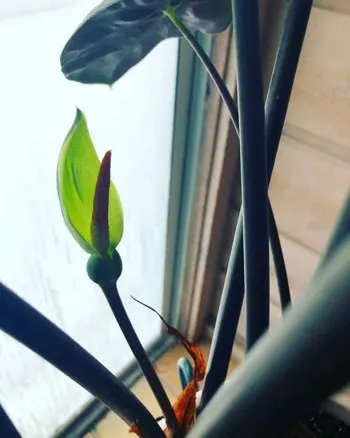

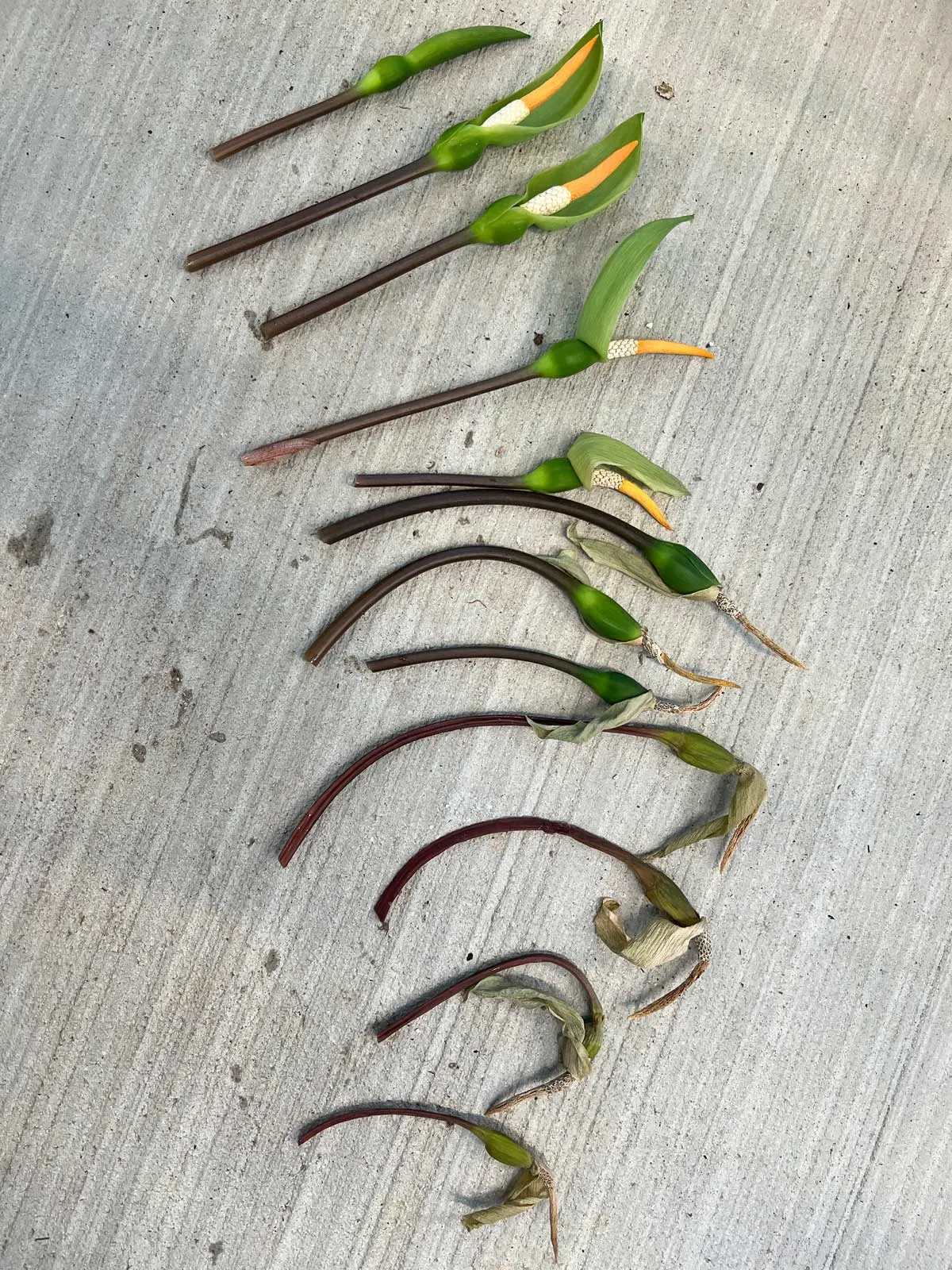
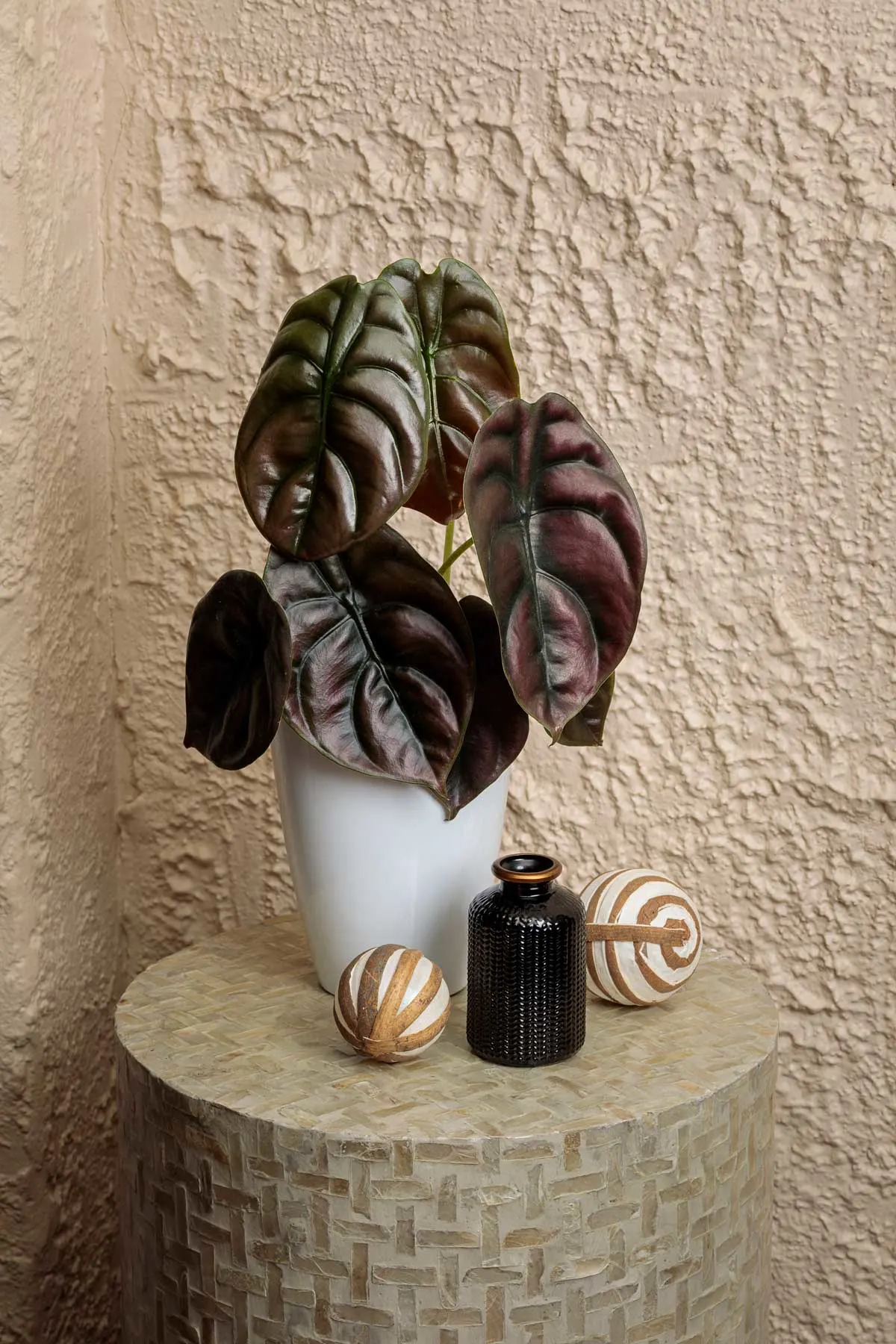
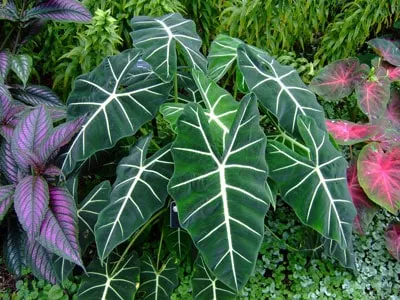
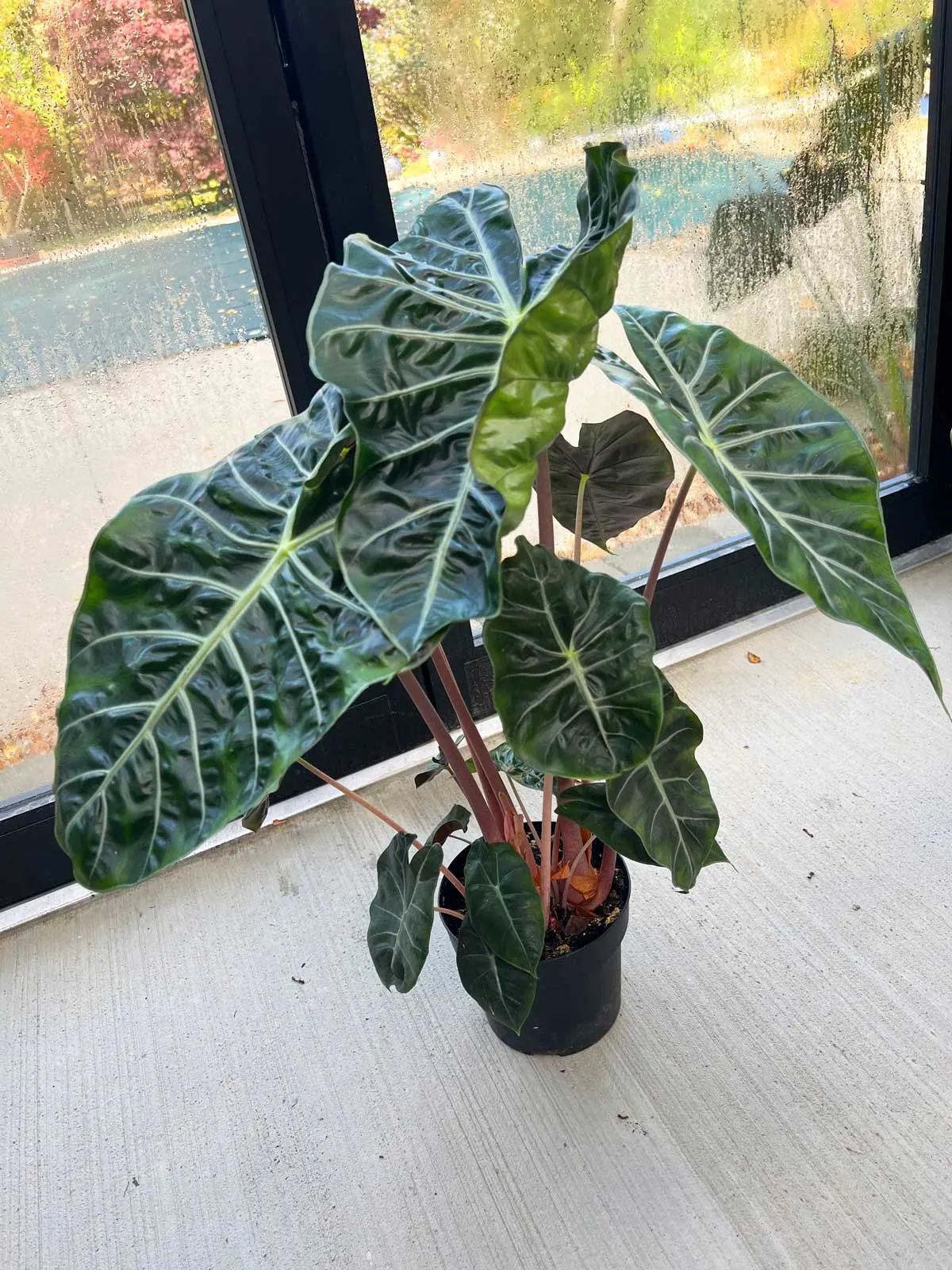
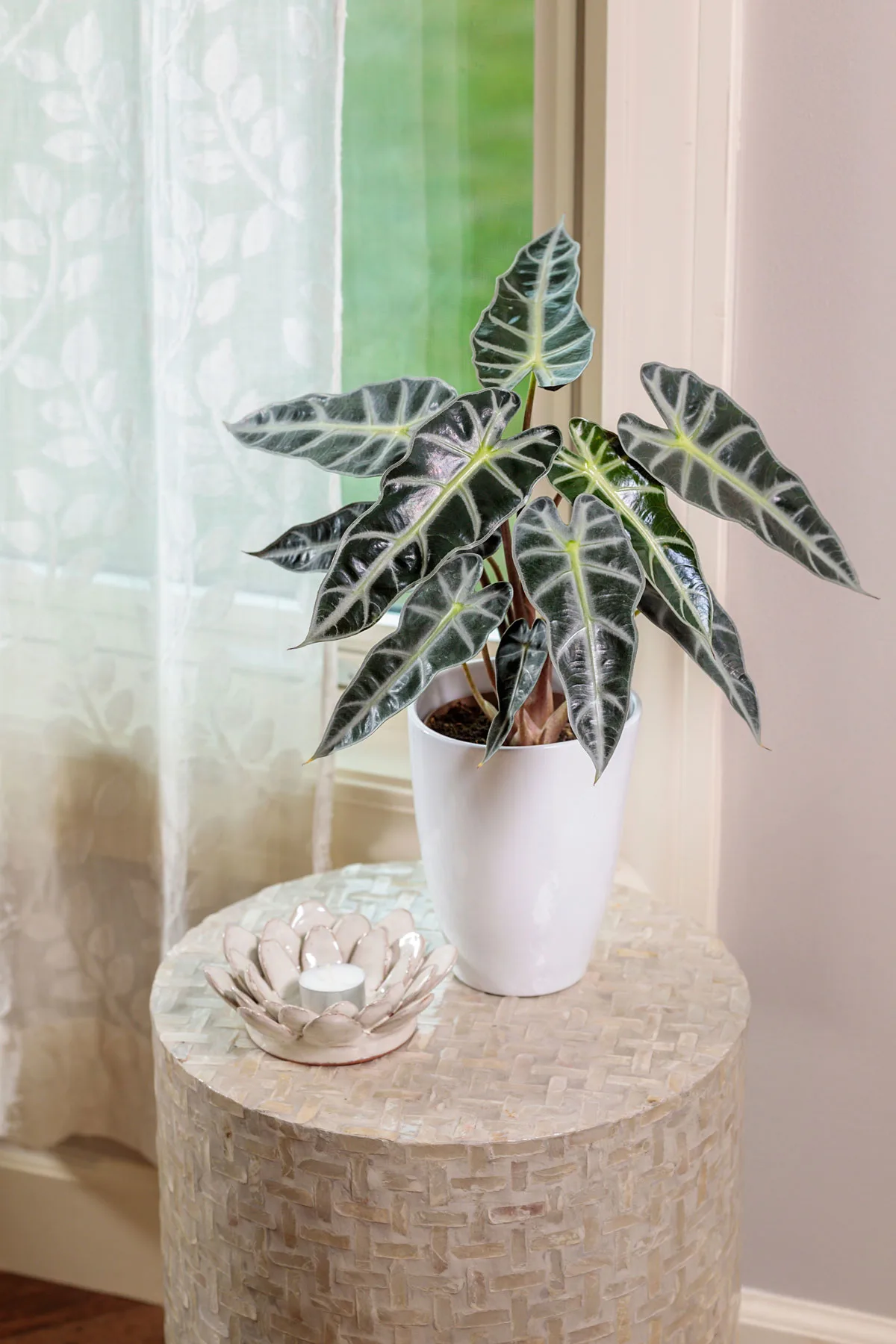
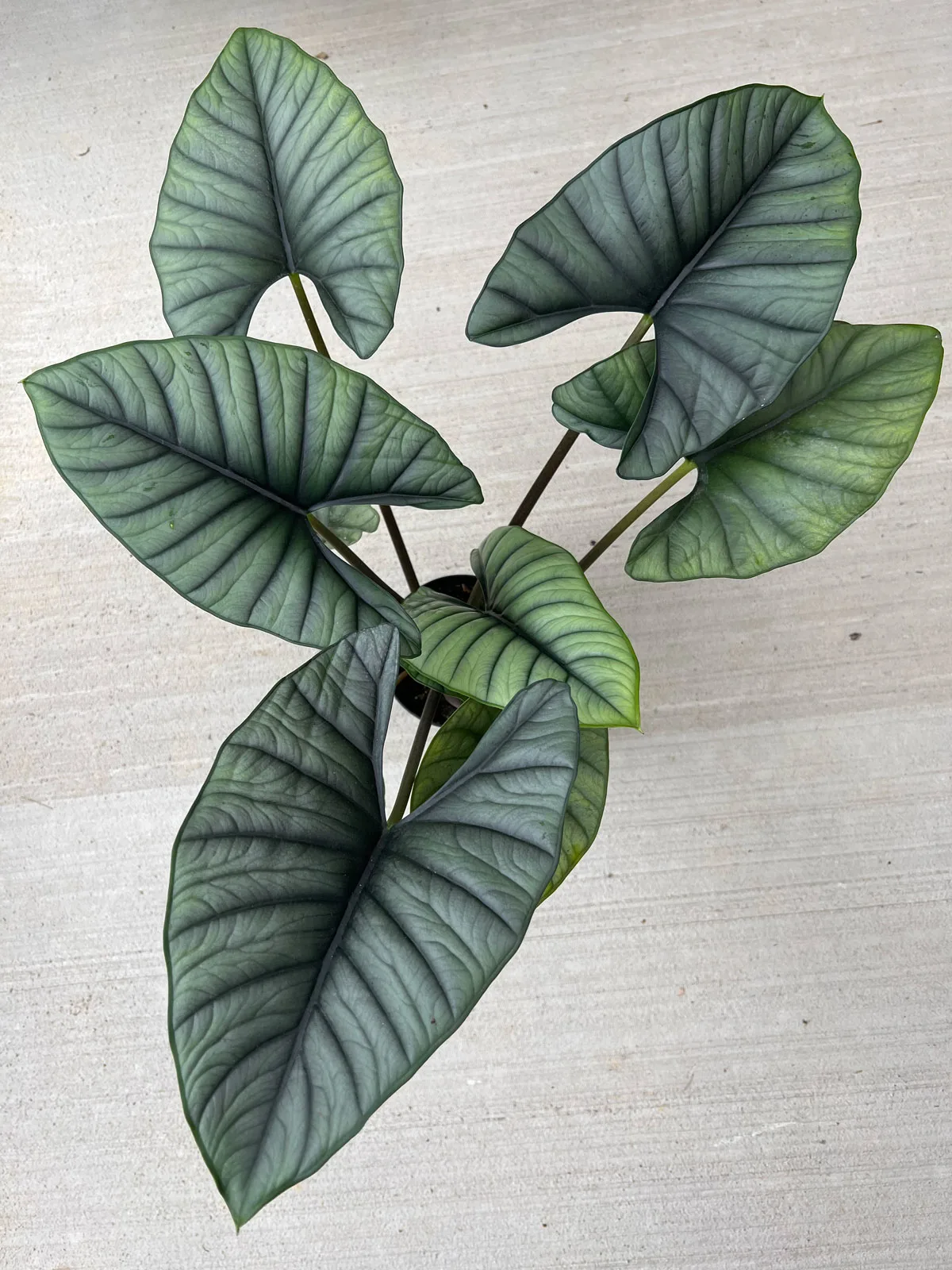
Donald Powell
Sunday 4th of February 2024
Thanks for the great article and information.
Live along the coast of Alabama and would love to move our outside this summer.
Is there a maximum temperature it can tolerate?
Thanks in advance. Don
Raffaele Di Lallo
Sunday 4th of February 2024
Hi Donald! Glad you found my post helpful! I would definitely keep your plant in full shade where you live. You should be ok with temperatures as long as you give your plant plenty of water! How hot does it get there in the summer?
Monica
Monday 26th of June 2023
Hi. My alocasia has dry brown edges on some leaves. I read this post . Can you please help me ?
Raffaele
Tuesday 27th of June 2023
Have you let your soil go too dry? Or have really low humidity? Those are a couple of ways you can get brown edges. Also being too close to a heating vent. I'd need to know more about your care in order to help.
Tina Seaman
Tuesday 20th of September 2022
I love your website! Soooo informative and precise!
Raffaele
Wednesday 21st of September 2022
Glad you enjoy it!
Libby St Clair
Friday 26th of August 2022
I had (yes, had) 2 alocasias for several years that succumbed to pests I inadvertently brought in on new plants this spring. This weekend I was giving all my houseplants an outdoor shower. and doing any necessary repotting and discovered that one of the alocasia pots that I carelessly discarded in the garage after removing the plant but without removing the soil was regrowing. It certainly looks like a baby alocasia. Right now it is in my "nursery" under grow lights and on a seeding mat. How should I care for this survivor?
Raffaele
Friday 26th of August 2022
They often come back from the corms! Try and keep it nice and humid and don't let it dry out. Where you have it right now is great.
Linda
Saturday 6th of August 2022
I have an alocasia Polly that was recently purchased about 2 wks ago. It had a brand new leaf starting to open. As it opened more it was almost transparent then as it opened more, it turned an orange/gold color with red edging. Today, when I did my daily plant inspections, the new leaf had died. I had it in front of a window with a humidifier keeping the humidity between 50% to 70% in the room. I feel the top of the soil and if dry I stick my finger down into the soil or use my water meter to check for dryness. I water if it's dry. I had just watered it yesterday with worm casting tea. So, why did my new leaf up and die on me? I have a pic but I don't see a way to share it on here. I did notice a new leaf starting down at the bottom of a stem and it's turned yellow. I'd say it was over watered but frankly, it wasn't. I really like this plant and knew it was going to be a challenge but I need advice to move forward with raising this beauty! Thanks.
Raffaele
Monday 8th of August 2022
Hi Linda. Hmmmm....can you use the contact form on my website to send me a message, when I reply, you can attach photos and we can go from there. If you can include additional information as well, that would be helpful. Such as lighting, what kind of potting mix you've used, and any other details.